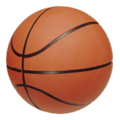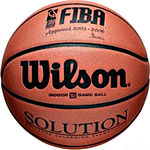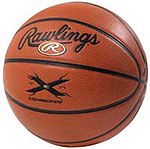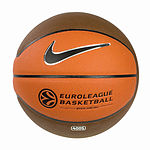- Basketball (ball)
-
A basketball is a spherical inflated ball used in the game of basketball. Basketballs typically range in size from very small promotional items only a few inches in diameter to extra large balls nearly a foot in diameter used in training exercises to increase the skill of players. The standard size of a basketball in the NBA is 29.5 to 29.875 inches (75 to 75.88 cm) in circumference.[1]
Nearly all basketballs have an inflatable inner rubber bladder, generally wrapped in layers of fiber and then covered with a tacky surface made either from leather (traditional), rubber, or a synthetic composite. As in most inflatable balls, there is a small opening to allow the pressure to be increased or decreased.
The surface of the ball is nearly always divided by "ribs" that are recessed below the surface of the ball in a variety of configurations and are generally a contrasting color. An orange surface with black ribs and a possible logo is the traditional color scheme of basketballs but they are sold in various colors.
Balls are generally designated for indoor (generally made of leather or absorbent composites), or all-surface use (generally made of rubber or durable composites, also known as Indoor/Outdoor balls). Indoor balls tend to be considerably more expensive than all-surface balls due to cost of materials. In addition, brand new all-leather indoor balls must be "broken in" first to achieve optimal grip before use in competition. The abrasiveness of asphalt and the dirt and moisture present in an outdoor setting will usually ruin an indoor ball within a very short period of time, which is why an indoor/outdoor ball is recommended for recreational players.
Aside from the court and the baskets, the basketball is the only piece of equipment necessary to play the game of basketball. During the game, the ball must be bounced continuously (dribbling), thrown through the air to other players (passing) and towards the basket (shooting). Therefore, the ball must be very durable and easy to hold on to. The basketball is also used to perform tricks (sometimes called freestyling), the most common of which are spinning the ball on the tip of one's index finger, dribbling in complex patterns, rolling the ball over one's shoulder, or performing aerobatic maneuvers with the ball while executing a slam dunk, most notably in the context of a slam dunk contest.
Contents
History
 A historic basketball.
A historic basketball.
In early December 1891, the chairman of the physical education department at the School for Christian Workers (now Springfield College) in Springfield, Massachusetts, instructed physical education teacher James Naismith, known to many as the inventor of basketball, to invent a new game to entertain the school's athletes in the winter season. Naismith assembled his class of 18 young men, appointed captains of two nine-player teams, and set in motion the first ever basketball game, played with a soccer ball and two peach baskets tacked to either end of the gymnasium. The first purpose-built basketballs were made from panels of leather stitched together with a rubber bladder inside. A cloth lining was added to the leather for support and uniformity (identity). A molded version of the early basketball was invented in 1942. From 1967 through 1976, the American Basketball Association (ABA) used a distinctive red, white and blue basketball that is still seen from time to time. For many years, leather was the material of choice for basketball coverings, however in the late 1990s, composite materials were put forth and have rapidly gained acceptance in most leagues due to their superior performance in harsh outdoor game conditions. A survey in 2007 showed that there were approximately 300 million basketballs in the United States.
Modern-day specifications
Organized basketball leagues generally have very rigorous specifications for the balls to be used in official competition including weight, inflation pressure, bounce, circumference, color, and materials used. Most leagues use very similar specifications for their balls which are referred to as size 7 (for men's competition) and size 6 (for women's competition) by manufacturers. However the specific wording and policy on manufacturers vary between leagues. Here are the official specifications for three popular leagues:
- The International Basketball Federation (FIBA) has very strict criteria for its certified basketballs: The ball must be size 7, bear the name of the manufacturer and a serial number. It must be made of either genuine or artificial/synthetic leather and must be free of toxic materials and materials which may cause allergic reactions, and must also be free of heavy metals and AZO colors, though FIBA does not specify a specific color for the ball. It must be between 749 millimetres (mm) and 780 mm (29.5-30.7 in) in circumference, it must bounce at least 1300 mm (51.2 in) when dropped from a height of 1800 mm (70.9 in) on a hard surface with a mass of more than 1 ton, and it must weigh between 567 grams (g) and 650 g (20-22.9 oz). The ball must also pass a battery of rigorous tests: a fatigue test where it is bounced 20,000 times at a reference pressure without leaking any air, and then perform to specification when dropped from the reference height (1800 mm); a heat test where it is stored in a room for 7 days at 70 Celsius (158 Fahrenheit) and show no difference in appearance or performance; a valve test where a dry inflation needle is inserted into the ball 100 times and the ball must not show any leakage afterwards; and a friction test where the outer surface must match or exceed friction requirements or perform to the testers' satisfaction in a practice game. The manufacturer of the ball must have been certified by FIBA, which entails submitting balls for testing and paying a $3,000 testing fee, paying $13,000 per year in licensing fees, and printing the FIBA logo on each ball. Any manufacturer may submit for testing and certification.[2]
- The National Collegiate Athletic Association (NCAA) has less stringent requirements: The ball must measure between 29.5 and 30 inches (749–762 mm) in circumference, bounce between 49 and 54 inches (1245–1372 mm) when dropped from a height of 6 feet (1829 mm), and must weigh between 20 and 22 ounces (567–624 g) for men's competition (size 7), and measure between 28.5 and 29 inches (724–737 mm) in circumference , bounce between 51 and 56 inches (1295–1422 mm) when dropped from a height of 6 feet (1829 mm), and must weigh between 18 and 20 ounces (510–567 g) for women's competition (Size 6). Though the NCAA does not specify a particular manufacturer for the ball in regular season play, the Wilson SOLUTION basketball is the official basketball of the NCAA tournament.[3]
- The National Basketball Association (NBA) allows only one official ball: The ball must be the official NBA game ball manufactured by Spalding. The ball is orange in color, 29.5 (749 mm) inches in circumference and weighs 22 ounces (624 g) (size 7). It must also be inflated to between 7.5 and 8.5 pounds per square inch. Starting in the 2006 season, the NBA switched to a new ball from Spalding that had a synthetic surface and a modified rib pattern (See section below). Until 2005 the ball had a leather surface. On December 11, 2006 the NBA decided to revert to the old leather ball due to numerous player complaints, lawsuits and injuries, mostly scratched hands, from the synthetic ball.[4] Spalding has manufactured the official NBA game ball since 1983.[5][6]
- The Women's National Basketball Association (WNBA) has similar requirements to the NBA: The ball must be the official WNBA game ball manufactured by Spalding. The ball must be orange and white in color, between 28.5 and 29 inches (724–737 mm) in circumference and weigh between 18 and 20 ounces (510–567 g) (size 6).[7]
Notable basketball manufacturers
Spalding
Spalding was the first company to produce a basketball for official use. Company founder A.G. Spalding made the first dedicated basketball in the last years of the 19th century at the behest of James Naismith. It has produced basketballs since that time and has produced the NBA’s official game ball since 1983. The company also produces a wide variety of balls for the consumer market, most notably its INFUSION ball which has a built-in pump to maintain proper inflation.
In June 2006 the NBA announced that Spalding would be introducing a new official game ball for play beginning in the 2006 season. It was made from a microfiber composite with moisture management that was supposed to provide better grip and feel. However, there were several complaints about the new basketball. Many players complained that the new ball was slippery, hard to hold and that the increased friction caused cuts on player's hands. Many elite players called for the NBA to bring back the old ball, even bringing a grievance to the National Labor Relations Board to revert to the original leather ball. On December 11, 2006, NBA commissioner David Stern announced that the NBA would switch back to the old leather model starting at the beginning of 2007. In 2007, Spalding became the Official Basketball Provider of the Ball4Real World Tour.[8]
Spalding will be the new supplier for NBL (Australia) in 2010.[9]
Molten
Molten, a Japanese sporting goods manufacturer, has the current contract to provide game balls for:
- All FIBA world championships and continental qualifying events.
- All FIBA Asia events.
- Many domestic leagues, including Argentina, Uruguay, England, Greece, Indonesia, Italy, Lithuania, the Philippines, Poland (women's), and Portugal.
Through the 2006-07 season, it had the contract to provide balls for both Europe-wide competitions organised by ULEB, the Euroleague and ULEB Cup (now the Eurocup). However, ULEB has now signed Nike as its ball provider.[10] Molten's top-of-the line product is the GL7/GL6, a leather ball with a distinctive 12-panel design, a high-density cushioning foam below the surface and special soft rubber seams, a flatter pebbled finish providing increased contact area and a flattened seam between the panels (called a "Full-Flat Seam"). Molten also produces a wide variety of balls at all price points for the consumer market.
Wilson
Wilson's top-of-the-line product is the SOLUTION ball, named for its ability to absorb moisture over the course of a game and retain its grip. The ball is the official ball of all NCAA postseason tournaments, most notably the men's and women's Division I tournaments, and is used by many NCAA teams during the season as well by many high school leagues. Like Spalding, Wilson produces a variety of balls for the consumer market as well.
Rawlings
Rawlings has manufactured basketballs since 1902. The company is known for producing a 10-panel ball (known as the TEN), along with traditional 8-panel balls. The TEN basketball is the official ball of the Amateur Athletic Union and the "Gus Macker", the largest 3-on-3 basketball tournament in the United States.[11]
Nike
Nike, as noted earlier, now has the contract to produce balls for ULEB (including the Euroleague). In the Philippines it is used in the NCAA and UAAP as the official ball of the tournament. All these competitions use the Nike 4005 Official Tournament Balls.
References
- ^ "Rules of the Game". USA Basketball. http://www.usabasketball.com/rules/rules.html. Retrieved 28 October 2011.
- ^ [1]
- ^ [2]
- ^ [3]
- ^ [4]
- ^ [5]
- ^ [6]
- ^ http://www.spalding.com/ball4real/ball4real.html
- ^ http://www.nbl.com.au/index.php?id=15&tx_ttnews[tt_news]=17608&tx_ttnews[backPid]=4&cHash=2f3e247944
- ^ "Euroleague Basketball Announces Partnership with Nike". Euroleague Basketball. 2007-06-28. http://www.euroleague.net/news/i/13989/180/item. Retrieved 2007-07-02.
- ^ :: Rawlings is a manufacturer of baseball gloves, composite bats, aluminum bats, wood bats, batting helmets, catcher's gear, team uniforms, basketballs, and footballs ::
Basketball History and General History of basketball · James Naismith · Variations of basketball · Glossary of terms · Outline · Index of articles

Rules Officials · 3 seconds · 5 seconds · Carrying · Double dribble · Foul · Goaltending · Traveling · Basket interference · Jump ball
Game play Positions · Layup · Slam dunk · Jump shot · Free throw · Three-pointer · Moves · Rebound · Assist · Dribble · Block · Screen · Flop · Cherry picking
Equipment Ball · Court · Key (lane) · Backboard · Breakaway rim · Shot clock
Clothing Basketball sleeve · Finger sleeve
Categories:- Balls
- Basketball equipment
- Inflatable manufactured goods
Wikimedia Foundation. 2010.







